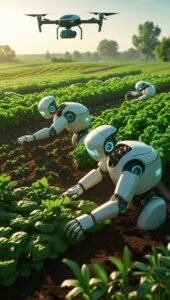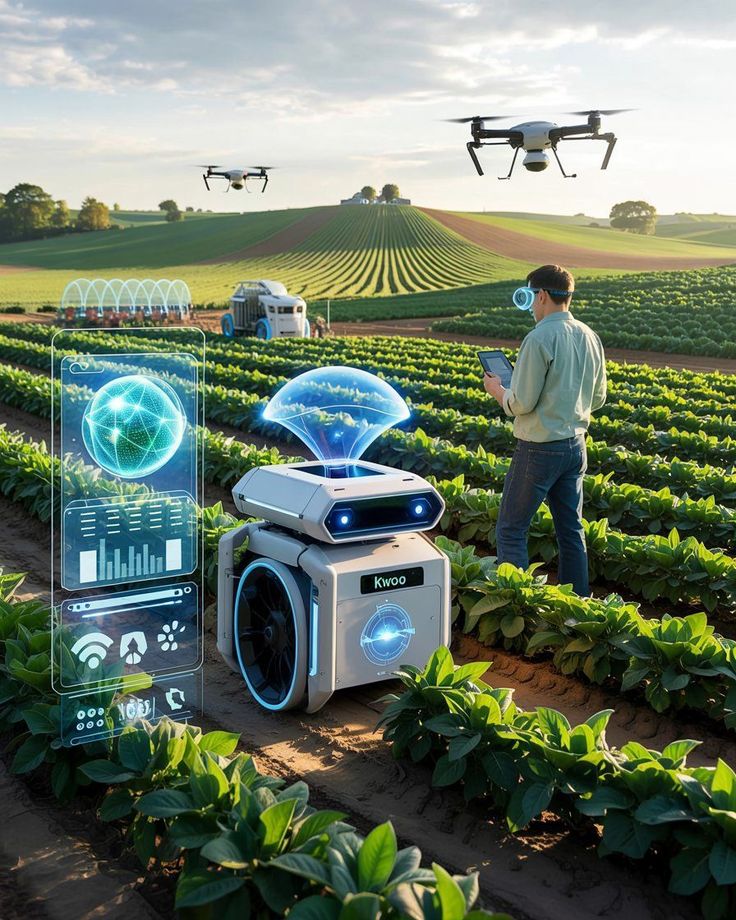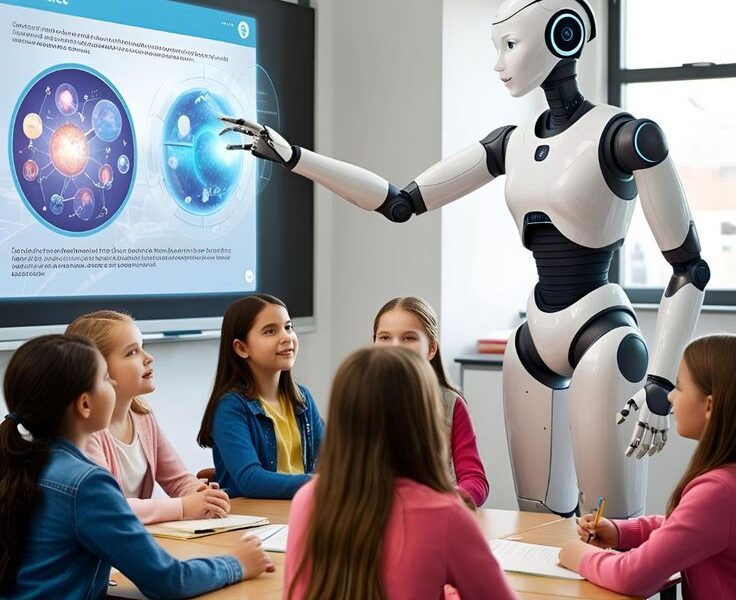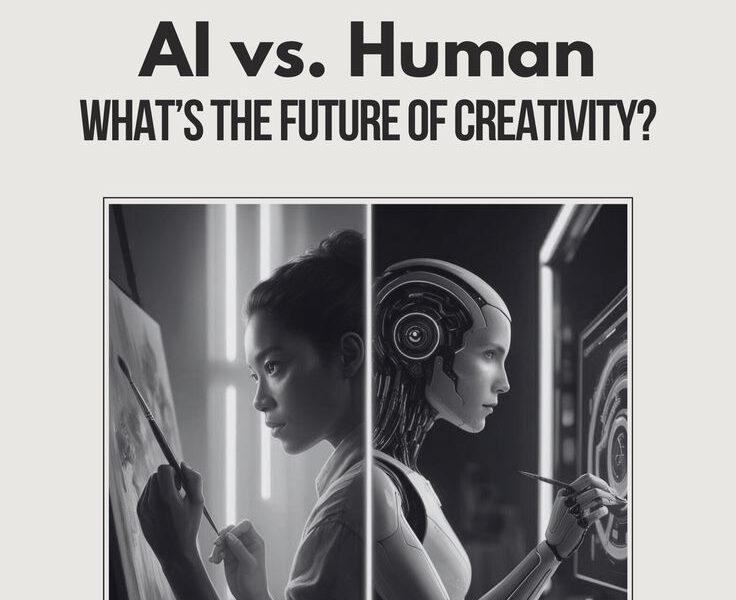## 🌱 **The New Dawn of Agricultural Revolution**
In the agricultural sector, the inclusion of artificial intelligence and robotics is proving to be the precursor to a revolutionary change that is altering all aspects of global food production, security, and distribution. These technologies are not only increasing productivity but are also setting new standards for food security and sustainability, which can guarantee food protection for future generations. The use of AI in modern agricultural robots is helping farmers increase yield per acre, while resources are also being used more effectively. These systems collect data in real-time and analyze crop health, soil moisture, and weather conditions, which helps farmers make timely decisions. AI-based systems can identify crop diseases at their inception, which reduces the use of medicine and promotes environmentally friendly agriculture. Automated irrigation systems are ensuring efficient water use while preventing water wastage, which is of particular importance for regions facing water scarcity. Examining fields through drone technology has now become easier, while robotic harvesters are taking the accuracy and speed of crop harvesting to new heights. All these developments together are transforming agriculture into a modern, science-based, and profitable sector, which can not only meet current needs but is also prepared to face future challenges.

### 📊 **The Digital Imprints of Crops**
In the modern era, agriculture is incomplete without data, and this is why the analysis of crop data with the help of AI and robotics is proving to be a new revolutionary link in the agricultural sector. High-resolution satellite imagery, drones, and hyperspectral cameras installed on ground robots now collect data that is beyond human vision, providing deep insight into crop health. These sensors analyze the interaction of plants with different wavelengths of light, especially in the near-infrared and shortwave infrared spectrum, which are invisible to the human eye. Healthy plants have a specific interaction with light that is completely different from stressed plants, and AI’s powerful models recognize these subtle differences to create detailed maps of crop health. Vegetation indices like NDVI are the numerical form of these maps, showing healthy areas in green and troubled areas in red, giving farmers immediate access to the precise location of the problem. But artificial intelligence’s capability is much deeper – it can not only identify the presence of a disease but also its specific type, and can accurately recognize nutrient deficiencies through changes in leaf structure and coloration. In weed management, artificial intelligence brings a revolutionary change, where robotic systems identify specific weed species and treat them separately, which significantly reduces the use of chemical medicines and protects the environment. Predictive analytical models have made it possible to accurately estimate crop yield, which helps farmers in planning. These models work by combining plant density, health quality, historical data, and weather forecasts, allowing for an accurate prediction of the final yield. This data-driven approach is transforming agriculture from a reactive sector into a proactive planning sector, where every decision is based on solid evidence.
### 🤖 **The Practical Emergence of Intelligent Machines**
The labor crisis and rising costs in the agricultural sector have made the use of autonomous robots inevitable; they are not only reducing the burden of physical labor but are also performing tasks that are highly repetitive or require precision for human workers. Autonomous tractors work in fields without a driver using GPS and LiDAR technology, performing tasks like plowing, sowing, and fertilizing with great accuracy, which saves time and allows for better resource utilization. In the field of selective harvesting, robotic harvesters have brought a revolutionary change; they are equipped with high-quality cameras and AI vision systems that analyze the fruit’s color, size, shape, and softness, and mechanical arms pick only those fruits that are in the correct state of ripeness, which increases quality production. In the field of micro-application, small robots and drones enable the targeted use of water, fertilizer, and medicines based on maps created by artificial intelligence, which can reduce the use of chemicals by up to 90%. In terms of energy, solar-powered robots have set a new standard of self-sufficiency, which are environmentally friendly and also cheap to run. The lightweight nature of these robots preserves the soil structure, while traditional heavy tractors damage the natural structure of the land, affecting soil fertility. These robots work 24 hours a day to take full advantage of the best harvest times, which is not possible for human laborers. Thus, the practical emergence of agricultural robots is not only increasing productivity but is also making agriculture a more precise, economical, and environmentally friendly sector, which meets the demands of the modern era.
### 💧 **Modern Systems of Intelligent Irrigation**
The global need for water conservation has highlighted the importance of AI-powered smart irrigation systems, which not only prevent water wastage but also improve crop health. These systems work on an extensive network of sensors installed in the ground that collect data on soil moisture, temperature, and air humidity in real-time, allowing for accurate determination of water needs. The AI controller works on the principle of Evapotranspiration, which calculates water loss from plants and the land surface, and combines this data with meteorological data to decide whether the plants need water or not. If there is already sufficient moisture in the soil or if rain is likely, the system automatically suspends irrigation, saving water. In drip irrigation and sprinkler systems, each nozzle can be controlled separately, enabling zonal irrigation and ensuring each section receives water according to its needs. In hyper-localized irrigation, autonomous robots go only to those specific plants that need water and deliver the exact amount of water near the root of each plant, so not a single drop of water is wasted. These systems not only save water but also improve crop health, because overwatering can cause root rot and diseases, which the AI system prevents. The system keeps farmers informed about its performance by sending mobile alerts, such as in case of a system leak or sensor failure, enabling timely repairs. Due to climate change, the importance of such intelligent systems increases even more with uncertain rainfall patterns, assuring farmers that their crops will remain safe in all kinds of weather conditions, be it drought or unexpected rain.
### 🌍 **Local Solutions to Global Problems**
The use of artificial intelligence and robotics in developing countries has provided solutions to their unique challenges, achieving significant successes despite problems such as small farms, traditional farming methods, and limited access to modern equipment. Mobile phone-based AI advisory systems are proving to be the most impactful solution, where farmers can take pictures of plants with their phones and upload them, and the AI identifies the disease or pest attack within seconds and suggests treatment, which is in the local language and can work even on low-speed internet. The development of low-cost robots has made automated solutions possible for small farmers; these are solar-powered and perform tasks like sowing seeds and weeding, and they can be manufactured locally. The Drones-as-a-Service model has made technology access easier for those farmers who cannot afford personal drones, where local companies provide imaging and analysis services via drones. AI systems provide farmers with information on market prices, demand and supply, and weather, which helps them in decision-making about which crop will be more profitable or where to sell their produce. Thus, artificial intelligence and robotics are not only solving production challenges but are also economically empowering farmers, which is increasing their income. These technologies are playing an important role in the fight for food self-sufficiency and against poverty in developing countries, and are proving helpful in making these countries self-reliant in terms of food security.
### ♻️ **The New Era of Sustainable Agriculture**
Artificial intelligence and robotics have opened new paths for achieving sustainable agriculture, whose central aim is to make agriculture environmentally friendly, preserving resources for future generations and protecting the ecosystem. In Integrated Pest Management, AI monitors and predicts pest populations and prefers biological methods such as the use of natural predators, which reduces reliance on chemical pesticides. If chemical treatment is necessary, robots spray only the affected plants, minimizing negative environmental impacts. In soil health restoration, AI and sensors analyze carbon content, organic matter, and microbial activity, which helps farmers choose appropriate cover crops for soil improvement, thereby restoring soil fertility. Lightweight robots prevent soil compaction, which improves soil health and keeps pathways for air and water circulation open. In terms of reducing carbon footprint, AI reduces nitrous oxide emissions through the targeted use of fertilizers, which is a powerful greenhouse gas, while electric-powered robots significantly reduce carbon emissions compared to diesel tractors. In protecting genetic diversity, AI analyzes data of local varieties that are resistant to diseases and climate change, which helps seed companies develop new, more sustainable varieties. In waste minimization, AI harvesters pick only quality fruits and vegetables, reducing the rate of crop loss, while better supply chain management reduces food waste. Thus, artificial intelligence and robotics are transforming agriculture from a sector that takes natural resources into one that provides protection to the environment, proving to be instrumental in leaving a healthy environment for future generations.
### 🔗 **The New World of Digital Platforms**
In modern agriculture, data has become the most valuable asset, without which modern agriculture is inconceivable, and the data obtained from every sensor, drone flight, and satellite image is being processed by artificial intelligence into actionable information that guides farmers. The agricultural platform or farm management system is the digital hub where all this data is aggregated, presenting the farmer with a digital twin of their field, where they can see soil moisture, disease hotspots, and the history of each plant in real-time, giving them complete awareness. This system not only shows the current situation but also makes future predictions through AI; for example, this model can predict the likelihood of fungus spreading after rain and suggest precautionary measures, which helps in controlling diseases. The platform’s interoperability creates harmony between different companies’ devices and software, allowing a farmer to use technologies from different sources that work on the same platform, which can be called a flexible system. In the fully automated farm of the future, this platform will make decisions automatically based on weather data; for instance, it will operate irrigation robots, activate weeding robots upon identifying weeds, and command harvesting robots when the crop is ripe, making a fully automated process possible. With this change, the farmer’s role will change from an operator to a strategist, who will monitor the system’s performance and make big decisions. This data will become part of a vast network, where anonymized data from thousands of farms will be used to improve AI models, enabling accurate predictions for the entire industry. Thus, this new world of agricultural platforms is transforming agriculture into a modern, data-driven, and highly efficient industry, which is in line with the demands of the modern era.
### 🚀 **Future Challenges and Opportunities**
Despite the introduction of artificial intelligence and robotics in the agricultural sector, several challenges remain that must be overcome to fully benefit from this technology. Cost and access are the biggest obstacles, especially for small farmers who cannot afford expensive equipment, but As-a-Service models have helped solve this problem, where farmers can lease the technology or avail its services. Digital literacy is another important challenge, which requires user-friendly interfaces and training in local languages so that farmers can easily use this technology. Creating clear laws and policies for data privacy and security is an urgent need of the time, so that farmers’ data remains safe. The lack of internet infrastructure in rural areas is also a problem, whose solution requires combined efforts from the government and private sector so that every farmer can have internet access. Despite these obstacles, future opportunities are bright, where in Swarm Farming, thousands of small robots will work together, performing field monitoring and maintenance tasks with great speed and efficiency. The combination of gene editing and artificial intelligence will help develop varieties resistant to diseases, which can resist climate change. The use of AI in vertical farming will increase production, where, in a completely controlled environment, AI will control light, temperature, humidity, and nutrients to maximize production. Artificial intelligence will play an important role in adapting to climate change, which is the biggest challenge of the coming times, and AI will analyze weather data to help develop new types of crops that can tolerate heat, drought, or floods. This journey, though difficult, is inevitable, and through artificial intelligence and robotics, agriculture is once again going to become the center of human development and success, which will not only satisfy our hunger but will also keep our earth safe, which will be a guarantee of a better future for coming generations.


